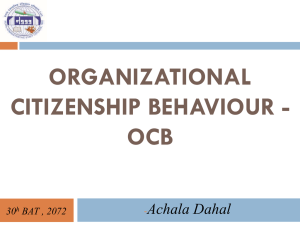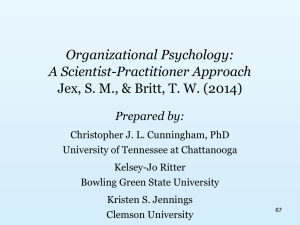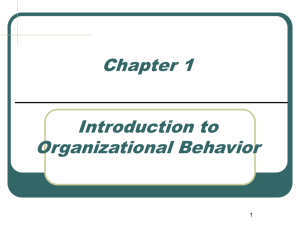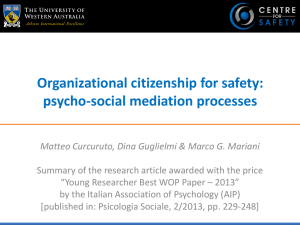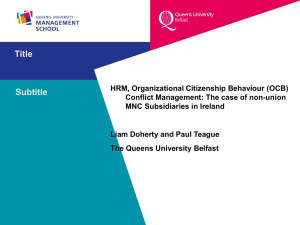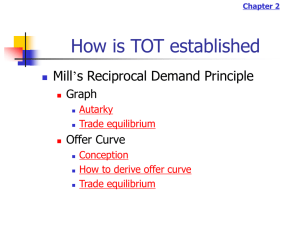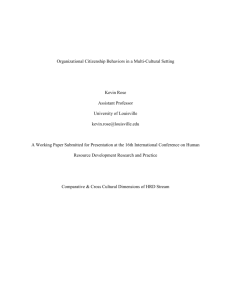Organizational Culture Values Influences to
advertisement
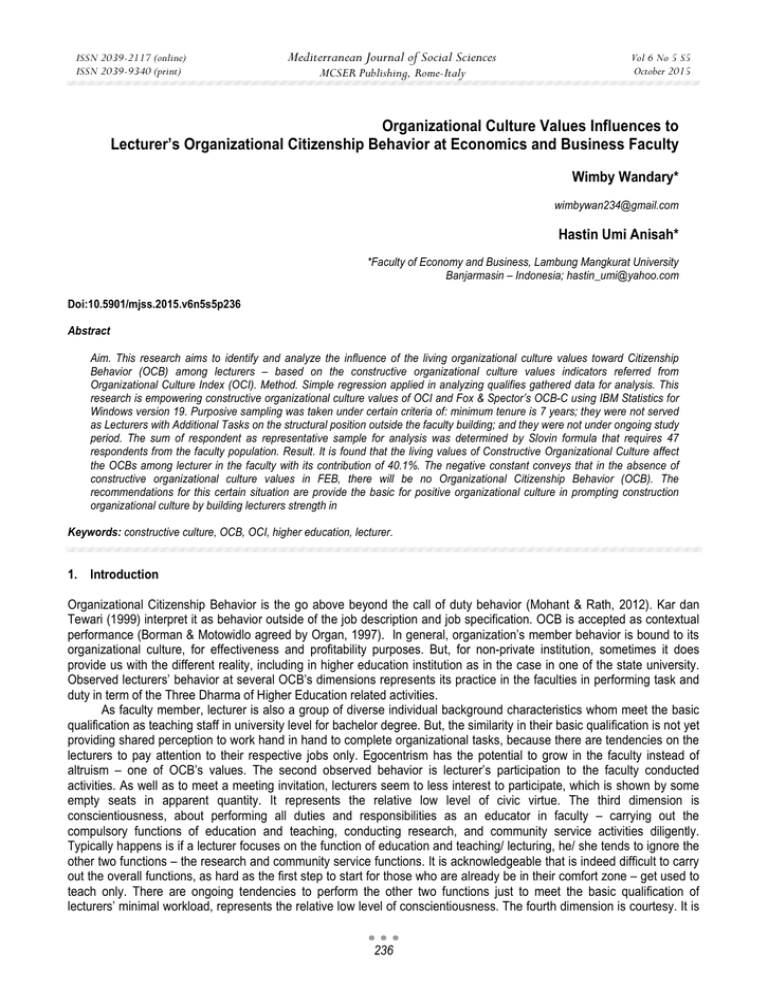
ISSN 2039-2117 (online) ISSN 2039-9340 (print) Mediterranean Journal of Social Sciences MCSER Publishing, Rome-Italy Vol 6 No 5 S5 October 2015 Organizational Culture Values Influences to Lecturer’s Organizational Citizenship Behavior at Economics and Business Faculty Wimby Wandary* wimbywan234@gmail.com Hastin Umi Anisah* *Faculty of Economy and Business, Lambung Mangkurat University Banjarmasin – Indonesia; hastin_umi@yahoo.com Doi:10.5901/mjss.2015.v6n5s5p236 Abstract Aim. This research aims to identify and analyze the influence of the living organizational culture values toward Citizenship Behavior (OCB) among lecturers – based on the constructive organizational culture values indicators referred from Organizational Culture Index (OCI). Method. Simple regression applied in analyzing qualifies gathered data for analysis. This research is empowering constructive organizational culture values of OCI and Fox & Spector’s OCB-C using IBM Statistics for Windows version 19. Purposive sampling was taken under certain criteria of: minimum tenure is 7 years; they were not served as Lecturers with Additional Tasks on the structural position outside the faculty building; and they were not under ongoing study period. The sum of respondent as representative sample for analysis was determined by Slovin formula that requires 47 respondents from the faculty population. Result. It is found that the living values of Constructive Organizational Culture affect the OCBs among lecturer in the faculty with its contribution of 40.1%. The negative constant conveys that in the absence of constructive organizational culture values in FEB, there will be no Organizational Citizenship Behavior (OCB). The recommendations for this certain situation are provide the basic for positive organizational culture in prompting construction organizational culture by building lecturers strength in Keywords: constructive culture, OCB, OCI, higher education, lecturer. 1. Introduction Organizational Citizenship Behavior is the go above beyond the call of duty behavior (Mohant & Rath, 2012). Kar dan Tewari (1999) interpret it as behavior outside of the job description and job specification. OCB is accepted as contextual performance (Borman & Motowidlo agreed by Organ, 1997). In general, organization’s member behavior is bound to its organizational culture, for effectiveness and profitability purposes. But, for non-private institution, sometimes it does provide us with the different reality, including in higher education institution as in the case in one of the state university. Observed lecturers’ behavior at several OCB’s dimensions represents its practice in the faculties in performing task and duty in term of the Three Dharma of Higher Education related activities. As faculty member, lecturer is also a group of diverse individual background characteristics whom meet the basic qualification as teaching staff in university level for bachelor degree. But, the similarity in their basic qualification is not yet providing shared perception to work hand in hand to complete organizational tasks, because there are tendencies on the lecturers to pay attention to their respective jobs only. Egocentrism has the potential to grow in the faculty instead of altruism – one of OCB’s values. The second observed behavior is lecturer’s participation to the faculty conducted activities. As well as to meet a meeting invitation, lecturers seem to less interest to participate, which is shown by some empty seats in apparent quantity. It represents the relative low level of civic virtue. The third dimension is conscientiousness, about performing all duties and responsibilities as an educator in faculty – carrying out the compulsory functions of education and teaching, conducting research, and community service activities diligently. Typically happens is if a lecturer focuses on the function of education and teaching/ lecturing, he/ she tends to ignore the other two functions – the research and community service functions. It is acknowledgeable that is indeed difficult to carry out the overall functions, as hard as the first step to start for those who are already be in their comfort zone – get used to teach only. There are ongoing tendencies to perform the other two functions just to meet the basic qualification of lecturers’ minimal workload, represents the relative low level of conscientiousness. The fourth dimension is courtesy. It is 236 ISSN 2039-2117 (online) ISSN 2039-9340 (print) Mediterranean Journal of Social Sciences MCSER Publishing, Rome-Italy Vol 6 No 5 S5 October 2015 the openness which manifested itself as willingness to share information with fellow faculty members. There are groups of faculty members, who have access to more information than others, especially by the non-formal manner, imply the existence of in-group and out-group. The last dimension is sportsmanship. It is the willingness to tolerate any organizational discomfort, as effort to create a pleasant environment and ideal workplace, as well as trying to keep positive attitude towards the organization by avoiding sweep under the carpet attitude. In fact, there is tendency to complaint in any non-formal communication about any discomfort rather than directly convey it formally. When organizations member occupied with these issues, it disrupts their expected performance. Organizational culture is an effective contributor to the goal achievements, in form of competitive advantage, organizational performance and OCB. It evidenced previously by several studies as by Mohant & Rath (2012), Ehtesham, Muhammad & Muhammad (2011), Wilcoxon & Millet (2000) dan Kar & Tewari (1999). Organizational culture viewed as basic assumption - espoused value – artifact, represents organizational personality. It served as a shared meaning system which the organization members held that distinguishes them to others, whom Schemerhorn Jr. et al (2010) meant by the internal adaptation function. The intended function is dealing with the collective identity creation and also deals with the way people working and living together. However, the other side, the external adaptation is about reaching goals, agenda, and activities, task accomplishment, strategy in achieving goals, until to the ability to cope with success or even failure. Therefore, the external adaptation abilities determine the organizational effectiveness. Organizational culture lives within day to day activities as the common way to perform among organization’s citizen. 2. Theoretical Review 2.1 Organizational Culture Defining organizational culture is contextual. Kar and Tewari (1999:423) define organizational culture is everything that individuals have learnt about their organizational world, which based on the observed past action consequences and the success’ failure of the attempts to cope up with the needs to avoid anxiety. Updated definition by Wagner III and Hollenbeck (2010) states that the nature of organizational culture are informal, shared way of perceiving life and membership in the organization which binds the organizational members and influencing the thought about themselves and about their work. Meanwhile, Schemerhorn et al (2010) mention that organizational or corporate culture is the system of shared actions, values, and beliefs that develops within an organization and guides the organization members’ behavior. Most of the attempt to define organizational culture is an elaboration that rooted from Schein (1983) classic definition that perceived organizational culture as the pattern of basic assumptions has invented by the given group, discovered, or developed in learning, it is meant to cope with its external adaptation and internal integration problems, and that have worked well enough to be considered as valid and, therefore, to be taught to new members as the correct way to perceive, think, and feel. His definition inspires further study for organizational culture. Recognizing organizational culture is recognizing its characteristic. Robbins (2005) identified 7 organizational culture characteristics lies on the low to high continuum, they are: innovation and risk-taking, attention to detail, outcome orientation, people orientation, team orientation, aggressiveness, and stability. Former meta analysis study by Hofstede et al (1990) reveals the existence of 6 organizational/ corporate culture characteristics, they are: holistic, historically determined, related to anthropological concepts, socially constructed, soft, and difficult to change, and 1 additional characteristic of: integrated in one construct. Understanding of the characteristics of organizational culture then the function can be empowered effectively. Empowering organizational culture requires an understanding about its function as well. According to Robbins (2005) organizational culture holds several functions to its entities. The first function is that culture serves as a boundarydefining role which distinct one organization to another. The next function is that it conveys a sense of identity for the members. The third function as facilitation for organizational members’ commitment to the larger interest than their selfinterest. The fourth function is an enhancement to the social system stability since it serves as the social glue that provides a hand to hold the organization together by providing certain standards for what they should say and do. And finally, organizational culture is a mechanism for sense-making and control to guide and shapes employees’ attitudes and behavior. 2.1.1 Types organizational culture Tharp (2009) acknowledges organizational culture as an important aspect for space planners. Then, he analyzes the 4 types of organizational culture, which are knows as: Control (hierarchy), compete (market), collaborate (clan) and create 237 ISSN 2039-2117 (online) ISSN 2039-9340 (print) Mediterranean Journal of Social Sciences MCSER Publishing, Rome-Italy Vol 6 No 5 S5 October 2015 (adhocracy). The typology reflects the organizational characteristics which range across the two critical organizational effectiveness dimensions. The other organizational culture study conducted Whittington and Dewar (2009:8) provides different organizational cultural styles to determine organizational effectiveness; it is through the lenses of Organizational Culture Inventory/ OCI. OCI concerns with the elements of task, people, basic human needs, and higher order needs, by identifying 12 cultural styles that fall into three areas organizational culture, such as: the Constructive cultures (which encourage members to interact with each other and solve problems in a manner that satisfies higher order needs); the Passive/Defensive cultures (which encourage members to interact with each other in a manner that neither facilitates nor disturbs the security of the status quo); and the last one is the Aggressive/Defensive cultures (which encourage members to approach tasks in a forceful way that builds their status and security). As for the indicators of the organizational culture is illustrated as follows. Figure 1. Organizational Culture Styles by OCI Source: Schemerhorn Jr, Hunt, Osborn & Uhl-Bien (2010:11) Meanwhile organizational culture is seen as a collective phenomenon. In his study, Hofstede (2011) in collaboration with Bob Waisfisz classifies organizational culture in eight dimensions, namely Hofstede’s Multifocus Model. It conveys the six autonomous dimensions and there are two semi autonomous dimensions. Hofstede defines organizational culture as the way in which members of an organization relate to each other, to their work and to the outside world in comparison to other organizations. The Dimensions enables a tangible alignment of Organizational Culture and Strategy. Hofstede’s six autonomous dimensions are well knows as these dimension of: means-oriented versus goal-oriented, internally driven vs. Externally driven, Easygoing work discipline vs. Strict work discipline, Local vs. Professional, Open system vs. Closed system, Employee-oriented vs. Work-oriented. And the semi-autonomous dimensions are: the Degree of acceptance to leadership style, and Degree of identification with organization. 2.1.2 Organizational Citizenship Behavior (OCB) The well known general idea of OCB was promoted by Organ (1988), who defines OCB as the discretionary individual behavior, which is not directly or explicitly recognized by the formal reward system, and promotes the overall effective functions of the organization. Organ’s definition underlies most of OCB studies. The brief explanation for discretionary behavior stated that it is the kind of behavior that is not an enforceable requirement in the role of job description; it is not clearly specifiable terms in someone’s employment contract. Bateman and Organ, 1985; Organ, 1990; Van Dyne et al., 1995 stated that discretionary behavior as personal choice as its omission which not generally understood as punishable. On the organizational practical perspective, Wagner III and Hollenbeck (2010) views OCBs as the action that promote organizational interests, but not formally stated as the part someone documented job requirements. There are behaviors considered as OCB practices, such as volunteering for assignments, going out of one’s way to welcome new employees, helping others who need assistance, staying late to finish a task, or voicing one’s opinion on critical organizational issues. In turn, OCBs tend to make the organization run more smoothly, but dissatisfied employees rarely engage in them. As Organ cited by Podsakoff et al (1997) clarifies several OCBs indicators. The first is altruism, it is the voluntary actions to 238 ISSN 2039-2117 (online) ISSN 2039-9340 (print) Mediterranean Journal of Social Sciences MCSER Publishing, Rome-Italy Vol 6 No 5 S5 October 2015 help else’s in working problem. The second indicator is Civic Virtue, the employee’s indicated behavior shows their responsibly participation, and concerned about, the company’s long live. The third indicator is Conscientiousness, the pattern of going well behavior beyond the minimum required levels of attendance, punctuality, housekeeping, conserving resources, and internal maintenance related matters. The fourth indicator is Courtesy, known as subsumes of all foresight full gestures to help else on preventing a problem. The last indicator is Sportsmanship, the employee’s willingness in tolerating less ideal work circumstances without complaints. At 2011, Fox and Spector provide us with Organizational Citizenship Behavior Checklist (OCB-C). OCB-C is a copyrighted instrument for OCB measurement which contains of the 20-item scale that specifically designed to minimize overlap with the scale of counterproductive work behavior. 2.2 Previous Study Previous study by Mohant dan Rath (2012) predicts organizational culture roles affects to OCB among three industrial sectors of manufacture, banking, and information technology, founds that organizational culture dimensions is affecting OCB significantly positive to each industrial sector. Another exploratory study conducted by Ehtesham et al (2011) finds the relationship among Denison’s organizational culture components and Performance Management Practices/ PMPs in higher education. There are four traits of Denison’s organizational culture components promoted, they are: involvement, consistency, adaptability and mission. It turns that at a confident level of 0.99 organizational culture has a significantly positive relationship with performance management practices in its two components of adaptability and mission, and each of the four organizational cultural traits of involvement, consistency adaptability and mission are positively and strongly associated with performance management practices. Wilcoxon and Millett (2000) attempted to describe the management of organizational culture in broader social context. They were conclude that what constitutes organizational culture and its perceived role in organizational success are contested, it is rest on the perceptions of culture, either as a historicallybased, change-resistant, deep social system for organizational strategy and action, or as just one aspect of the total organizational system, manipulate-able through surface structures such as rewards. Kar & Tewari (1999) promotes testing on two propositions about the impact of organizational culture’s individual component to OCB simultaneously and partially to the sample contains of 400 employees from two manufacturing units from eastern India. It employed the organizational culture’s questionnaire developed by Parida, Mathur, and Kurana in 1991. It conveys that OCB is positively and significantly correlated with all components (sub-variables) of organizational culture, they are support, Structure, Performance Reward, Individual Autonomy, Conflict Tolerance, Risk Tolerance, Identity, Individual Responsibility, Beliefs and Norms. Partially, it founds that organizational culture component of support having the highest level of positive and significant influence to OCB’s dimension of altruism. Beytekin et al (2010) specific studies the organizational culture for university level. He claimed that culture shifted from being used as a descriptive device to become linked with improvement and success which pattern higher education followed. The most recent competitive evolution of universities worldwide has lead to the changing nature of higher education, and also the changing social, political and economical forces which affects the institutions in every aspect. Consequently from those changes, the researches on the universities’ culture became more of an issue. They found that organizational culture is not sufficient to enhance organizational performance, hence must be aligned closely with the actual policies and practices to obtain the high degree of integration and coordination by the management. 3. Research Method The application of quantitative approach is apply by simple regression to find out the constructive organizational values influence to organizational citizenship behavior among faculties. Basically, this regression aims to calculate the average score of dependent variable based on the independent’s variable score, testing dependency of hypothesis’ characteristic, and to predict the average score of the independent variable based of the independent variable score out of the sample’s range (Sarwono, 2012) This study questioned whether the living values of Constructive Organizational Culture affecting the OCBs level among faculties. Fox and Spector’s 20 items copyrighted OCB-C questionnaire being empowered in finding this circumstances among faculty members. Constructive organizational culture consists of several indicators of achievement/ ach, self-actualization/ sac, humanistic encouraging/ hec, and affiliation/ aff. Purposive sampling generated determined by Slovin (Tejada & Punzalan, 2012) there are 47 primary data from about 100 distributed questionnaires, which qualified for further testing from the completeness respond of questionnaires items. The sample criteria are: minimum tenure is 7 years; they were not served as Lecturers with Additional Tasks on the structural position outside the faculty building; and they were not under ongoing study period. Descriptive statistics for 239 Mediterranean Journal of Social Sciences ISSN 2039-2117 (online) ISSN 2039-9340 (print) Vol 6 No 5 S5 October 2015 MCSER Publishing, Rome-Italy organizational culture shows the average score of 4.2405 with deviation standard of 0.4228. The deviation consider as low because the score is smaller than 20% of mean score which equal to 0.85. Average score for OCBs is 3.5787 with deviation standard of 0.6449. The deviation consider as high because the score is larger than 20% of mean score which equal to 0.7157. There a wide range of deviation in OCBs value in than faculty than the living constructive organizational culture values. To provide the qualify data for further analysis, it is necessary to find whether there are outliers to be excluded. Under significant level of 5%, normal distributes data must in range between (-1.96) to (+1.96). I turn there are 2 outliers. However, they are still include for further analysis under certain assumption, that a matter of fact there explicit statement of establishment of the faculty’s organizational culture. The operating organizational culture tends to be the operating culture – the living values of constructive organizational culture even though its potential development is not yet being well acknowledge. So, there are feasible data for test of research instrument. Constructive organizational culture instrument is proven to be valid that resulted score of the corrected total item correlation above r-table (+0.294) and it is reliable with resulted Alpha Cronbach score of 0.864. Afterwards, for the OCBC instrument, it is also proven to be valid with resulted Alpha Cronbach score of 0.934. To predict the operating culture values of constructive organizational culture effect of OCBs among faculty members, simple regression been applied. Regression analyses for research variable are presented below. Table 1. Research Variable Variables Entered/Removed Model Variables Entered 1 BOa a. All requested variables entered. b. Dependent Variable: OCB Variables Removed . Method Enter Table 1 provides to identify research variables. Organizational culture (BO) served as independent variable, and the dependent variable is organizational citizenship behavior (OCB). Table 2. Model Summary Model R 1 .644a a. Predictors: (Constant), BO R Square .414 Adjusted R Square .401 Standard Error of the Estimate .4990292 Summarized model shows the Correlation Coefficient/ R is 0.644 shows that there is a relatively strong relationship among two variables, since it is above 0.5. The R-Square/ R2/ determination coefficient conveys how good is the formed regression model, revealing score of 0.414 interpreted as OCB is contribute to affect organizational culture values of 41.4% and the rest of 58.6% affected by other factor beside OCB, which is not being study in this research. Table 3. Analysis of Variance Model Sum of Squares Regression 7.927 1 Residual 11.206 Total 19.134 a. Predictors: (Constant), BO b. Dependent Variable: OCB ANOVAb df 1 45 46 Mean Square 7.927 .249 F 31.833 Sig. .000a The above table of Table 3 is uses to determine the level of significance or the regression linearity, which its criteria based on the F test or the score of significance test (Sig.). Practically, this research refers to use the score or significance for the If the Sig. < 0.05. Since the resulted score of Sig. is 0.000 then the regression model is significant, which mean it is fulfill the linearity criteria. 240 ISSN 2039-2117 (online) ISSN 2039-9340 (print) Mediterranean Journal of Social Sciences Vol 6 No 5 S5 October 2015 MCSER Publishing, Rome-Italy Table 4. Regression Coefficientsa Unstandardized Coefficients Standardized Coefficients Model B Std. Error Beta (Constant) -.584 .741 1 BO .982 .174 .644 a. Dependent Variable: OCB t Sig. -.788 .435 5.642 .000 The above table of Table 4 informs the acquired regression model from the constant and the Unstandardized coefficient B in common of Ǔ = -0.584 + 0.982X which equals to the regression model of OCBs = (-0.584) + 0.982BO. Furthermore, previous analysis conveys that the model of regression consider as significant or feasible to predict. The negative constant (-0.584) means that without organizational culture (BO) the OCBs among faculty members (in this case is lecturers) is negative. We assume ‘negative OCBs’ as the very low condition, that some of faculty members implement OCB values as the part of their morality – as their spiritual believe that she/ he must be a good and responsible person regardless anything else under organizational context. If you are good person, then be good. The positive B-coefficient of organizational culture (+0.982) represents the great effect of organizational culture to OCB level among faculties by increasing it. Since this is a social study and the measurement based on the existed theory, the standardized coefficient beta of 0.644 is applied, which also mean the increasing or applying organizational culture will increasing the level of OCB among faculties. So the regression model become Ǔ = -0.584 + 0.644X which equal to OCB = -0.584 + 0.644BO. The increases or establishing organizational culture (or constructive organizational culture with the living values of achievement, self-actualization, humanistic-encouraging, and affiliation) will provide leverage for OCBs that will increase to live the value of altruism, civic virtue, conscientiousness, courtesy, and sportsmanship among faculties. 4. Conclusion and Recommendation Alternative research hypothesis is accepted that the living values of Constructive Organizational Culture affect the OCBs among lecturer in the faculty. There is relatively strong relationship between research variable of OCB and organizational culture among faculties, resulted in the Correlation Coefficient 0.644; it is contribution to organizational culture is 41.4%. The regression model is linear by the Sig. of 0.000. The model of OCB = -0.584 + 0.644BO reveal that the without of organizational culture resulted in the negative condition of OCB which is very low. The existence of OCN will increase the faculties OCB. It is recommend establishing and shaping organizational culture, specially the constrictive one, so it will polish faculty’s atmosphere which promote lecturers willingly of discretionary behavior. There are potentials in applying constructive organizational culture explicitly. Positive organizational culture is the outcome, which can be achieved by building lecturer’s strength through encouraging Tri Dharma Perguruan Tinggi in supporting research and community service activities – financially or institutionally, providing proper facilitation for lecturing activities, and arranging ethical code of conduct to provide the basic for achieving super-ordinate goals. Yes, there is sanction for ethical and academic misconduct, but encourages more on reward (non-financially) and focus on positive outcome on performance. Emphasizing vitality and growth by recognizes differences between job and career, personally and professionally. There are faculty members whose living the value of OCBs even it just few person. To reinforce it habitually, facilitating their positive attitude will provide them and other observer will draw attention and provide fair model to have a sense of belonging positively. Empowering rather than delude them. Refernces Beytekin, Osman Ferda., Yalçinkaya, Münevver., Do÷an, Miray., And Karako, Nermin. 2010. The International Journal Of Educational Researchers 2010, 2(1):1-13 Ehtesham, UI Mujeeb., Muhammad, Tahir Masood., & Muhammad, Shakil Ahmad.(2011). Relationship between Organizational Culture and Performance Management Practices: A Case of University in Pakistan. Journal of Competitiveness. Issue 4/2011. 78-88. Hofstede, Geert. (2011). Dimensionalizing Cultures: The Hofstede Model in Context. Online Readings in Psychology and Culture, 2(1). htt://dx.doi.org/10.9707/2307-0919.1014 Hofstede, Geert; Neujien, Bram; Ohayv, Denise Danal; and Sanders, Geert. (1990). Measuring Organisational Cultures: A Qualitative and Quantitaive Study Across Twenty Cases. Administrative Science Quarterly. Vol. 35. No. 2. June. 286-316. 241 ISSN 2039-2117 (online) ISSN 2039-9340 (print) Mediterranean Journal of Social Sciences MCSER Publishing, Rome-Italy Vol 6 No 5 S5 October 2015 Kar, D.P and Tewari, H.R. (1999). Organizational Culture and Organizational Citizenship Behavior. Indian Journal of Industrial Relations. Vl. 34. No. 4. April. 421-433. Mohant, Jagannath dan Rath, Bhabani P. (2012). Can Organizational Culture be a Predictor of Organizational Citizenship Behaviors? International Journal of Innovation, Management and Technology, Vol. 3, No. 1, February. 76-79 Mohanty, Jagannanth & Rath, Bhabani. (2012). Influence of Organizational Culture on Organizational Citizenship Behavior: A Three Sector Industry. Global Journal of Business Research. Vol.6, No.1. 65-76. Organ, Dennis W. (1990). The Motivational Basis of Organizational Citizenship Behavior. Research in Organizational Behavior. Vol. 12. 43-72 Organ, Dennis W., (1997). Organizational Citizenship Behavior: It’s Construct Clean Up Time. Human Performance. 10 (2), 85-97. Organ, Dennis. (1988). OCB: The Good Soldier Syndrome. Lexington Books. Lexington: MA. Organizational Citizenship Behaviors?. International Journal of Innovation, Management and Technology, Vol. 3, No. 1, February. 76-79 Robbins, Stephen P. (2005). Organizational Behavior. 11th edition. International Edition. Pearson. New Jersey: Prentice Hall. Sarwono, J. (2012). Contoh Regresi Liner Sederhana dengan SPSS. Retrieved August 8, 2013, from www.narotama.ac.id: http://statistikbisnis.narotama.ac.id/download_berita/Contoh%20Regresi%20Linier%20Sederhana%20dengan%20SPSS.pdf Schein, Edgar H. (1984). Coming to a New Awareness of Organizational Culture. Sloan Management Review, 25:2. Winter. 3-16. Schemerhorn Jr. John R., Hunt, James G., Osborn, Richard N., and Uhl-Bien, Mary. (2010). Organizational Behavior. 11th ed. USA: John Wiley & Sons.. Schemerhorn, Jr., John R., Hunt, James G.., & Osborn, Richard N. (2002). Organizational Behavior. 7ed. John Wiley & Sons, Inc.: USA. ISBN 0-471-22819-2 (ebook). Schemerhorn, Jr., John R., Hunt, James G.., Osborn, Richard N., & Uhl-Bien, Mary. (2007). Organizational Behavior. 11ed. John Wiley & Sons, Inc. USA. Tejada, J. J., & Punzalan, J. R. (2012). On the Misuse of Slovin’s Formula. The Philippine Statistician Vol. 61, No. 1 , 129-136. Tharp, B. M. (2009). Four Organizational Culture Types. Retrieved August 8, 2010, from Haworth on line: http://www.haworth.com/enus/knowledge/workplace-library/Documents/Four-Organizational-Culture-%20Types_6.pdf Wagner III, John A., and Hollenbeck, John R. (2010). Organizational Behavior: Securing Competitive Advantage. New York: Routledge. Whittington, Dave and Dewar, Tammy. (2009). How to Create a Healthy Corporate Culture. Calliope Learning. Victoria: Calliope. Wilcoxon, Lesley & Millet, Bruce. (2000). The Management of Organizational Culture. Australian Journal of Management & Organizational Behavior, 3(2). 91-99. 242
